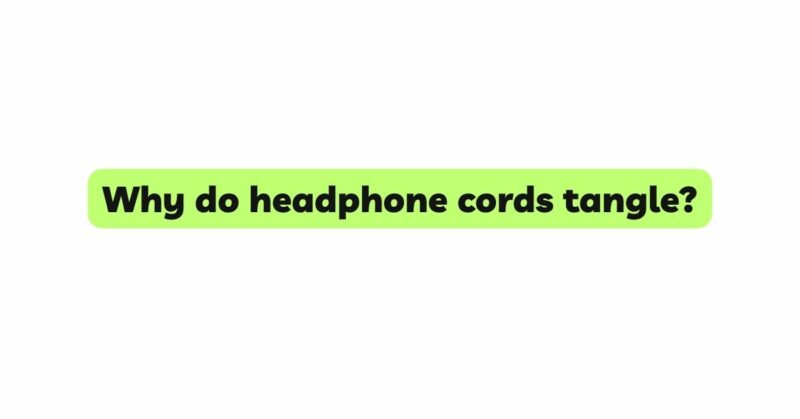The modern world thrives on technology, and few gadgets have become as ubiquitous as headphones. Whether it’s for listening to music, taking calls, or watching videos, headphones have become an integral part of our daily lives. However, despite their convenience, there is one annoyance that headphone users universally face: tangled cords. It seems that no matter how carefully we store them, headphone cords have an uncanny ability to become entangled within seconds. This article aims to delve into the science behind why headphone cords tangle, exploring the physics and human behavior that contribute to this frustrating phenomenon.
- The Nature of Tangles:
Before we explore the reasons behind tangled headphone cords, it is essential to understand what constitutes a tangle. Tangles occur when cords become twisted and interwoven in such a way that they hinder free movement or usage. The complexity of a tangle can range from simple knots to intricate knots and loops that seem almost impossible to unravel.
- Physics of Knot Formation:
The formation of knots in headphone cords can be attributed to several physical factors. One significant factor is the natural tendency of flexible materials to form knots when subjected to random movements. This phenomenon, known as “self-entanglement,” occurs when the cord undergoes repetitive and random bending, coiling, and twisting.
The cord’s material plays a crucial role in knot formation. Most headphone cords are made from materials like rubber or plastic, which possess a certain level of elasticity. When the cord is coiled or bent, it stores potential energy, and when released, this energy propels the cord to spring back to its original shape. These elastic forces can lead to spontaneous knotting, even when the cord is seemingly left undisturbed.
- Aggravating Factors:
Several external factors contribute to the aggravation of headphone cord tangling. One of the most significant factors is the human element. Users’ actions, such as carelessly stuffing the headphones into pockets or bags, can cause the cords to become tangled. The act of pulling or tugging on the cord when removing them from storage can also exacerbate the situation.
Additionally, the environment in which the headphones are stored can also play a role. Cluttered spaces, such as bags or desk drawers, provide ample opportunities for cords to become entwined with other objects, further complicating the tangle.
- Mathematical Complexity:
The mathematics behind knot formation is surprisingly complex and has long intrigued mathematicians and physicists. The study of knots falls under the realm of topology, a branch of mathematics that deals with the properties of space that are preserved under continuous deformations, like stretching and bending.
Researchers have studied different knot types and analyzed their behavior under various conditions to better understand their formation and behavior. While the mathematics involved can be quite intricate, it helps shed light on the underlying principles of tangle formation.
- Solutions and Mitigations:
Given the common frustration of tangled headphone cords, several solutions and mitigations have been proposed to minimize this issue. Some headphone manufacturers have explored the use of tangle-resistant materials and cord designs to reduce the likelihood of knots forming in the first place. This includes using flat or braided cords, which are less prone to tangling than traditional round cords.
Additionally, some companies have introduced wireless headphones, eliminating the problem of tangled cords altogether. Wireless technology has become increasingly popular, and its adoption has significantly reduced the headache of cord management.
For those who still prefer wired headphones, there are various accessories available, such as cord organizers and cases, which help keep the cords neatly wrapped and organized.
- Understanding Human Behavior:
Apart from the physical aspects of tangle formation, understanding human behavior can also offer insights into why headphone cords tend to become tangled. Studies have shown that humans have a natural inclination to arrange and order things in patterns, including coiling and looping cords. This behavior is often driven by the desire for tidiness and efficiency.
However, this organizational instinct can sometimes work against us, as we may inadvertently create knots and tangles when trying to manage the cords. Being aware of these tendencies can help users adopt more conscious habits in handling their headphones, potentially reducing the frequency of tangling incidents.
Conclusion:
In conclusion, the mystery of why headphone cords tangle lies at the intersection of physics, mathematics, and human behavior. The inherent flexibility of cord materials, coupled with random movements and user actions, creates an environment conducive to knot formation. While the mathematical complexities of knots remain an active area of research, various solutions and cord management techniques can alleviate this persistent inconvenience. As technology continues to evolve, wireless headphones are becoming an increasingly popular alternative, offering users a tangle-free listening experience. Nevertheless, understanding the science behind tangled headphone cords enables us to be more conscious in our habits and better manage the everyday annoyance that many of us face.


